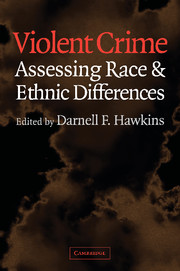Book contents
- Frontmatter
- Contents
- Contributors
- Foreword
- Editor's Introduction
- Violent Crime
- Part I Homicide Studies
- 1 Homicide Risk and Level of Victimization in Two Concentrated Poverty Enclaves: A Black/Hispanic Comparison
- 2 Moving Beyond Black and White Violence: African American, Haitian, and Latino Homicides in Miami
- 3 Homicide in Los Angeles County: A Study of Latino Victimization
- 4 Economic Correlates of Racial and Ethnic Disparity in Homicide: Houston, 1945–1994
- 5 The Race/Ethnicity and Poverty Nexus of Violent Crime: Reconciling Differences in Chicago's Community Area Homicide Rates
- Part II Other Contexts, Settings, and Forms of Violence
- Part III Explaining Racial and Ethnic Differences
- References
- Index
1 - Homicide Risk and Level of Victimization in Two Concentrated Poverty Enclaves: A Black/Hispanic Comparison
Published online by Cambridge University Press: 22 August 2009
- Frontmatter
- Contents
- Contributors
- Foreword
- Editor's Introduction
- Violent Crime
- Part I Homicide Studies
- 1 Homicide Risk and Level of Victimization in Two Concentrated Poverty Enclaves: A Black/Hispanic Comparison
- 2 Moving Beyond Black and White Violence: African American, Haitian, and Latino Homicides in Miami
- 3 Homicide in Los Angeles County: A Study of Latino Victimization
- 4 Economic Correlates of Racial and Ethnic Disparity in Homicide: Houston, 1945–1994
- 5 The Race/Ethnicity and Poverty Nexus of Violent Crime: Reconciling Differences in Chicago's Community Area Homicide Rates
- Part II Other Contexts, Settings, and Forms of Violence
- Part III Explaining Racial and Ethnic Differences
- References
- Index
Summary
Introduction
Regardless of race or ethnic status, victims of homicide in the United States are drawn most often from the lower socioeconomic classes. More recently, however, a growing number of researchers have begun to focus attention on the context and/or environment in which homicide within the lower socioeconomic classes occurs (See Morenoff and Sampson 1997; Almgren and others 1998; Krivo and Peterson 1996). More often than not, this means focusing attention on urban neighborhoods described as economically disadvantaged or as neighborhoods of concentrated poverty (Massey 1995). The current focus on concentrated poverty neighborhoods as a primary environment of concentrated homicide victimization is partially an outgrowth of interest in the phenomena described as the underclass. Underclass research had its origins in work done in the 1980s (see Glasgow 1980; Murray 1984; Wilson 1987; Auletta, 1981).
The validity of the concept of the existence of an urban underclass in the United States and its various definitions have been severely criticized, and is not universally accepted among academic researchers. In this instance, we focus our attention on two sets of urban neighborhoods that satisfy the definition of extreme poverty neighborhoods, that is, 40 percent poor, in a single large Midwestern urban center. It is in neighborhoods that transcend this poverty threshold that homicide victimization rates are usually highest. It is in neighborhoods like these that researchers have identified a number of critical dimensions that are thought to lead to elevated homicide risk (see Sampson, Raudenbush, and Earls 1997).
- Type
- Chapter
- Information
- Violent CrimeAssessing Race and Ethnic Differences, pp. 3 - 21Publisher: Cambridge University PressPrint publication year: 2003
- 1
- Cited by



